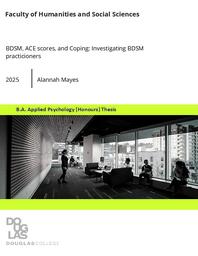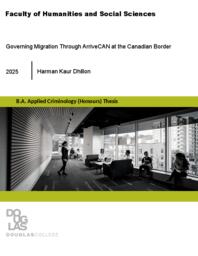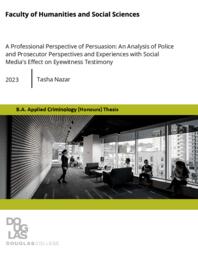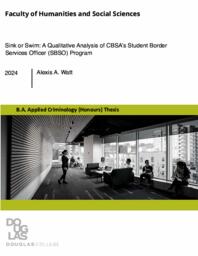Douglas College
Related Works
Content type
Digital Document
Abstract
This study is interested in understanding the relationship between BDSM and emotional approach coping skills. This is under a theoretical assumption that there are positive benefits to being a regular practitioner of BDSM. Some stereotypes of people who practice BDSM involve a pathological or traumatized narrative. To test this assumption ACE scores were also measured along with both positive and negative coping skills. This research hopes to provide more clarity to the growing knowledge of positive sexuality as a healing tool.
Origin Information
Content type
Digital Document
Description / Synopsis
This study sought to examine the construction of the ArriveCAN app that was used during COVID-19, and added to the interdisciplinary and criminological literature relating to the digitization of the border in relation to these constructions and uses of the ArriveCAN app.
Origin Information
Content type
Digital Document
Abstract
This mixed-methods study examined the perceived effectiveness and user experience of a voice-delivered cognitive behavioural therapy (CBT) exercise using ChatGPT, with the aim of evaluating its potential as a scalable and accessible mental health support tool. Quantitative data from pre- and post-intervention measures of the Thought Control Questionnaire (Wells & Davies, 1994) revealed significant improvements in adaptive thought control strategies (social control, reappraisal) and decreases in maladaptive strategies (worry, punishment). Qualitative data, analyzed through inductive thematic analysis of open-ended responses, revealed participants' recognition of the intervention's human-like responses, immediacy, and insight. Ethical concerns in mental health care are critical, and in this study, all artificial intelligence (AI) outputs were rated as neutral and appropriate, with 92% of participants feeling neutral or safe while engaging with the exercise. System- and user-level limitations were identified, including interruptions during user input and unfamiliarity with the platform's features and capabilities. Findings support generative AI as a promising adjunct to traditional therapy in expanding access to psychoeducational tools. Future research should explore longitudinal effects, address additional ethical considerations, and evaluate outcomes across diverse populations to ensure equitable and effective use.
Origin Information
Content type
Digital Document
Abstract
Canada’s correctional institutions are largely private and hidden from public view; because of this, much of the public gets their information regarding the criminal justice system from popular media. As it stands, there is a lack of research regarding the portrayal of correctional guards in popular media. A large portion of research pertaining to correctional guards is focused on how guards are portrayed in news media rather than popular media. The existing research into correctional guards in news presents them in a negative light with a tendency to focus on non-prisoner harassment, crime unrelated to the job, and budgetary issues (Vickovic et al., 2013). This thesis presents the result of qualitative exploratory study using content analysis as a means of understanding how correctional guards are portrayed in popular media. Ten of the top thirty grossing prison films released between 1994 and 2024 were analyzed thematically using grounded theory methods. The results show that correctional guards are generally portrayed as violent, aggressive, lazy, and lack respect for the prisoners. The significance of this study not only includes adding to popular criminology research but also offering a potential explanation for some motivations of becoming a correctional guard and explaining the gendered aspects of the ways in which correctional guards are portrayed and implications that may have on prisoners.
Future implications of this study include contributing to the literature surrounding prisoning, correctional guards, and popular criminology and transforming people’s views and perceptions regarding correctional guards by pointing out protentional inaccuracies.
Origin Information
Content type
Digital Document
Abstract
This study explores the complex relationship between alcohol use and occupational identity among musicians working within nightlife venues in Vancouver, British Columbia. While prior research has examined alcohol consumption in the hospitality sector, little attention has been paid to musicians as a distinct labor group operating within similarly permissive and criminogenic environments. Drawing on semi-structured interviews with active musicians, this research investigates how alcohol functions within the music industry, as a social lubricant, coping mechanism, reputational tool, and workplace expectation. The study applies Erving Goffman’s (1959) dramaturgical model to understand how musicians perform identity in alcohol-saturated spaces, and Sampson and Laub’s (1993) life course theory to examine patterns of desistance over time. Findings reveal that alcohol use is deeply embedded in the professional and cultural expectations surrounding live performance, with drinking often seen as integral to networking, performance energy, and audience engagement. However, many participants also expressed increasing awareness of the long-term personal and professional consequences of sustained alcohol use, leading some to reject or renegotiate their relationship with alcohol. By situating musicians within broader criminological frameworks, this study contributes to a deeper understanding of how occupational contexts shape behavior and identity in high-risk cultural industries
Origin Information
Content type
Digital Document
Abstract
Every day, people across the country log onto Twitter, Facebook, Instagram, and other forms of public communication to get the latest information on significant events happening in their communities. One of the more newsworthy categories is often crime stories. For those who have witnessed a crime, turning to social media can become a form of influence that can affect their statement to the police and in court. This study takes a qualitative approach to examine themes consistent with social media’s influence on eyewitness testimony. The project accomplished this by conducting six in-depth interviews with three police officers and three prosecutors. All the police officers were employed in the RCMP Major Crimes division, with two being part of the interview team at one point in their careers. Two prosecutors worked as trial crown council members for the BC Prosecution Service for most of their law careers. The last decided to keep their affiliations confidential. Five themes were discovered during the study. These themes included social media’s status as neither good nor bad, eyewitnesses’ decreasing importance in court, social media’s impact on how participants talk with witnesses, the case-by-case nature of everything in the justice system and the differing definitions of social media.
Origin Information
Content type
Digital Document
Abstract
Autistic burnout, characterised by chronic exhaustion, reduced tolerance to stimuli, and loss of executive function skills (Raymaker, et al., 2020) has severe consequences, including heightened mental and physical health problems, reduced capacity for independent living, decreased quality of life, and suicide attempts (Arnold et al., 2023a; Higgins et al., 2021; Mantzalas, Richdale, Adikari, et al., 2022b; Raymaker et al., 2020). Although autistic burnout has been validated as a syndrome that is distinct from depression and occupational burnout (Higgins et al., 2021; Raymaker et al., 2020), it is unclear if mental health treatment providers are able to distinguish depression from autistic burnout (Rose, 2018). Yet, some treatments such as Cognitive Behavioural Therapy (CBT) and Behaviour Activation (BA) may be ineffective or contra-indicated (Higgins et al., 2021). Considering the limited literature on autistic burnout, the complexity of treating it, and the possible harm involved in providing a treatment that may be contraindicated, it is critical to gain a deeper understanding of this syndrome. This study aimed to explore Autistic experiences accessing treatment for autistic burnout and their perspectives on the effectiveness of the treatments that were offered to them. Eleven participants completed semi-structured interviews. Qualitative analysis was informed by an interpretive phenomenological analysis (IPA) framework using a hybrid inductive-deductive approach at a semantic level. Participants reported that clinicians often failed to identify autistic burnout and generally lacked knowledge of the condition. Misdiagnoses were common, leading to treatments that delayed recovery and exacerbated symptoms of autistic burnout. Participants described negative experiences accessing support, including lack of support services, which eroded their faith in the healthcare system. Potential effective treatments and supports were identified, primarily the need for rest and practical support. These findings highlight the need to raise awareness among clinicians about the nature of autistic burnout, the importance of collaborating with the Autistic client to develop a treatment plan, and the general need for more services for Autistic adults.
Origin Information
Content type
Digital Document
Abstract
Each summer, hundreds of Canadian post-secondary students are recruited by Canada Border Services Agency (CBSA) under the Federal Student Work Experience Program (FSWEP) to become Student Border Services Officers (SBSOs). In a paid, non-union role, students act in similar capacities to full-time Border Services Officer (BSO) labour. This thesis provides an in-depth analysis of the never before examined SBSO program in an academic context. Through qualitative interviews conducted with former SBSOs, a wide range of issues were uncovered, from low wages to poor culture, in addition to the challenges and tribulations associated with the examination of insular organizations, such as CBSA.
Origin Information
Content type
Digital Document
Abstract
Offenders and crime, especially those with a violent nature, are rife within the news media. However, little research exists pertaining to these offenders who are going to be, or nearing, their release on parole. This thesis aimed to extend prior literature by conducting two qualitative content analyses. The first included a general selection of Canadian parole-based newspaper articles from 2002 to 2022 in order to create a foundation of how parole is represented in the media. The second was an in-depth analysis that drew upon articles from a male offender (Larry Takahashi) and a female offender (Joanna Larson) to compare representations based on gender. This exploration uncovered four central themes, the types of crimes published, gender of offenders, age of victims, and the usage of certain language. The results of this study revealed several implications related to community attitudes, and public policy.
Origin Information










